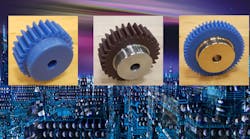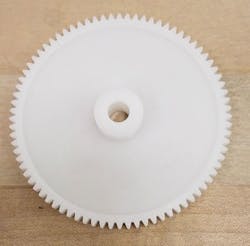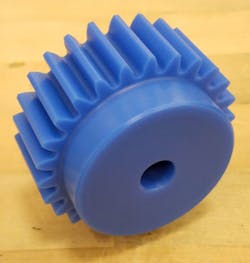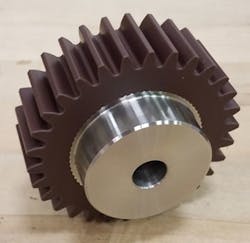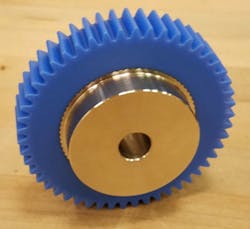Plastic gearing has been increasing in usage as designers better understand their benefits and limitations. These gears can be produced by hobbing or stamping or, for large-volume runs, by injection molding. Some of the key benefits of plastics in the production of gearing are:
- Reduced weight and lower inertia due to the lower density of the material
- Ability to absorb shock and vibration due to the elasticity of the material.
- Reduced noise.
- Low coefficient of friction
- Self-lubricating in most cases.
- Able to be used in wet environments and food preparation areas.
However, as with all materials, there are also some drawbacks to using plastic materials in gears. These include:
- Less load-carrying capacity compared to similarly sized metal gears.
- Molded gears cannot hold the same high tolerances that metal gears can.
- Plastic is less dimensionally stable when compared to metal and this results in dimensional variations due to temperature and humidity conditions.
- Material cost is significantly higher than that of base metals and can vary widely due to fluctuations in the cost of base chemicals.
- Difficulty in attaching plastic gears to metal shafts.
The most common plastics used in the production of gearing include acetal and nylon. However, within this group there are many variations. Various acetals are produced under trade names such as Delrin, Duracon, and Celcon. Each of these brand names include various formulations that manipulate the product mechanical properties. They may add lubrication or improve tensile strength or may make the material suitable for food contact. Similarly, there are various tradenames for nylon including MC901, MC602ST, Nylaton GSM and many others. The nylons used for gearing are typically type six, although type 12 is also known to be used. The designation of nylon type is determined by the number of methyl ethylene (CH2) atoms on each side of the nitrogen atom in the polyamide chain. Thus, Nylon 12 has 12 methyl ethylene atoms on each side, which also indicates a higher degree of crystallization. Crystallization is important to note as it inhibits the absorption of water, so Nylon 12 will handle moisture better than Nylon 6.
Plastic acetal gear
Plastic nylon gear
In most applications, acetal is used for molded gearing and nylon is used for machined gearing. Acetal is dimensionally stable, is resistant to most chemicals, and does not absorb moisture. However, it does require continuous lubrication when subject to high loads. Nylon is less dimensionally stable as it does vary in shape in response to both temperature and humidity. The advantage of nylon for use in gearing is that it is typically self-lubricating. When using acetal as a material for gearing, there is always a concern that the raw material may contain voids. This is not an issue when using cast nylon.
Many designers are reluctant to use plastics for their gear design due to the lower strength of the material when compared to metals. One of the ways to improve the strength of nylon gears is to cast the material in bar form and add some type of fiber to the mix, thereby increasing the compressive strength. One such material is MC602ST. This is a type-six nylon with a 30% fiberglass fill. A gear made with 30% fiberglass fill that includes a carbon steel core can be bored, keyed, and tapped for any shaft-mounting configuration, yet the outer rim has all of the benefits of being a plastic gear.
For an apples-to-apples comparison of a solid nylon spur gear, a nylon spur gear with a stainless-steel core, and a reinforced nylon spur gear with a carbon steel core, results in the following: (The following materials properties are taken from the PS (solid nylon), PU (stainless steel), and the NSU (carbon steel) series from KHK.)
Setting the toque limit of the MC901 solid nylon gear at 100 Nm, the maximum allowable bending strength torque for an equivalent stainless-steel hub gear with a MC901 rim would also be 100 Nm. These values are the same because the gear will fail at the tooth, thus rendering the material of the core inconsequential.
Plastic MC602ST gear with carbon-steel core
Plastic stainless-steel core with MC901 rim gear
However, the equivalent carbon-steel core gear, with a 30% fiberglass fill nylon rim, will have a maximum allowable bending strength torque of 138 Nm. This 38% increase in torque capacity without sacrificing any of the benefits of nylon gearing nor increasing the design envelope, can be quite appealing to some designers.
A new material blend mixes -ix nylon with a 30% carbon fiber fill. This gear has a maximum bending strength torque capacity of 207 Nm as compared to the solid MC901 nylon gear. It has a bending strength torque capacity that is equal to that of steel, which is 1.5x the capacity of aluminum.
Some of the benefits of this new material, carbon-fiber reinforced plastic (CFRP), are:
- It eliminates the drawback of lower load carrying capacity as it is equal to steel in bending strength.
- It has a density which is 1/6 that of steel and ½ that of aluminum.
- It has a tensile strength that is double that of plain nylon, is 1.5x greater than glass filled nylon, and equal to aluminum.
- Its bending elasticity is 4.5x greater than MC901 solid nylon and double that of glass-filled nylon.
- It is self-lubricating and can be bored, keyed, and tapped to high tolerances, as it machines just like steel.
The current limitation for widespread use of this material in gearing is the cost. A simple MC901 spur gear with a base cost around $70 would be approximately $240 if produced as a carbon-steel core, with a 30% fiberglass filled nylon rim-style gear, and $450 if produced as a stainless-steel core, with an MC901 nylon rim-style gear. This same gear produced as a solid CFRP gear would cost approximately $1,400.
Although the initial cost is high, the benefits in many applications could be justified as a long-term investment. Consider an outer-space application wherein the strength of a steel gear is needed but size and weight constraints limit the design to the use of plastic. The CFRP would be an excellent choice due to its high strength, low weight, and self-lubricating properties. Another opportunity would be inside of a machine that takes several days to disassemble for maintenance. By using a CFRP gear inside of this mechanism, the maintenance cycle could be extended, saving valuable downtime for production.
Plastic CFRP gear
The various types of plastics lend themselves to different applications. Molded acetal gears are common in most household items such as paper shredders, refrigerator ice dispensers, ink-jet printers, and most home-use power tools. This material is typically selected for these applications because the cost of molding thousands of pieces is quite inexpensive and because the material is durable under most environmental conditions.
Machined nylon gears are typically used in applications that handle more torque and power. Typical applications for nylon gearing are conveyor systems, packaging equipment, and industrial automation. Many times, nylon is used as a gear material in order to reduce the noise of a metal gear train or to reduce vibration.
Nylon gears can also be introduced as a failsafe in a complex drivetrain. When used as a failsafe, the designer acknowledges that the system could suffer a catastrophic failure, and by including a sacrificial nylon gear in the system, they can prevent damage to the rest of the drive. When the system experiences a peak load exceeding that of the design, the first component to fail will be the plastic gear. This can save thousands of dollars of equipment or spare the life of someone nearby.
With all these materials available, it is important to find the right one for your application and understand the new technology that is evolving the gear industry into applications that might not yet exist.
